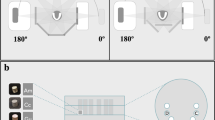Abstract
To evaluate the clinical usefulness of gantry tilt scanning as an image reconstruction technique for avoiding artifacts caused by metallic dental fillings. Gantry tilt scanning was used with multidetector-row computed tomography for imaging in patients with dental fillings. Using a novel PC-based program, the oblique images obtained were reconstructed to transverse images using nearest neighbor and bilinear interpolation methodologies in order to avoid metallic streak artifacts. Coronal images were reformatted with the reconstructed transverse images, and the continuity of the reconstructed images was evaluated. Gantry tilt scanning was performed in 12 patients with metal artifacts, and the original and reconstructed images were classified into four grades and assessed by two radiologists. Results of the clinical evaluation indicated that the original images with artifacts, only 4% had good image quality in the region around the medial pterygoid muscle, only 8% depicted areas around the internal carotid artery and internal jugular vein, and only 12% could depict the areas around the parotid gland in the clinical evaluation. These values were improved to 60, 96, and 100%, respectively, in the reconstructed transverse images. Gantry tilt scanning as an image reconstruction technique improves image quality and removes most, if not all, artifacts caused by metallic dental fillings. The resulting images can be used in the evaluation of oropharyngeal lesions in patients with dental fillings.












Similar content being viewed by others
References
Dammann F, Horger M, Mueller-Berg M, Schlemmer H, Claussen C, Hoffman J, et al. Rational diagnosis of squamous cell carcinoma of the head and neck region: comparative evaluation of CT, MRI, and 18FDG PET. AJR. 2005;184:1326–31.
Suojanen JN, Mukherji SK, Dupuy DE, Takahashi JH, Costello P. Spiral CT in evaluation of head and neck lesions. Work Prog Radiol. 1992;183:281–3.
Charnlei N, Morgan A, Thomas E, Wilson S, Bacon S, Wilson D, et al. The use of CT–MR image registration to define target volumes in pelvic radiotherapy in the presence of bilateral hip replacements. Br J Radiol. 2005;78:634–6.
McGahan JP, Walter JP, Bernstein L. Evaluation of the parotid gland. Radiology. 1984;152:453–8.
Barrett FF, Keat N. Artifacts in CT: recognition and avoidance. Radiographics. 2004;24:1679–91.
Zhao S, Robertson DD, Wang G, Whiting B, Bae KT. X-ray CT metal artifact reduction using wavelets: an application for imaging total hip prostheses. IEEE Trans Med Imaging. 2000;19:1238–47.
Kalender WA, Hebel R, Ebersberger J. Reduction of CT artifacts caused by metallic implants. Radiology. 1987;164:576–7.
Roeske JC, Lund C, Pelizzari CA, Pan X, Mundt AJ. Reduction of composed tomography metal artifacts due to the Fletcher-Suit applicator in gynecology patients receiving intracavitary brachytherapy. Brachytherapy. 2003;2:207–14.
Sennst DA, Kachelriess M, Leidecker C, Schmidt B, Watzke O, Kalender WA. An extensible software-based platform for reconstruction and evaluation of CT images. Radiographics. 2004;24:601–13.
Wang G, Frei T, Vannier MW. Fast iterative algorithm for metal artifact reduction in X-ray CT. Acad Padiol. 2000;7:607–14.
Glover GH, Pelc NJ. An algorithm for the reduction of metal clip artifacts in CT reconstruction. Med Phys. 1981;8:799–807.
Nasada T, Hirayama S, Tanooka M, Fujita T, Sakai T. Evaluation of gantry tilt correction in multi detector-row CT: effect on multi-planar reconstruction images. Radiol Technol. 2002;59:136–42.
Nakae Y, Sakamoto K, Minamoto T, Kotoura N, Ozaki T, Johkoh T. Improvement of metal artifacts in dental structure by X-ray CT: reconstruction of transverse images using oblique images by gantry tilt scanning. Radiol Technol. 2006;62:863–6.
Acharya T, Tsai P. Computational foundations of image interpolation algorithms. ACM Ubiquity. 2007;8.
Xin Li X, Orchard MT. New edge-directed interpolation. IEEE Trans Image Process. 2001;10:1521–7.
Nakae Y, Inoue H, Minamoto T, Yamamoto T, Johkoh T. Influence and improvement of metal artifacts in dental structure by CT for radiation treatment planning: reconstruction of transverse images using oblique images by gantry tilt scanning. Radiol Technol. 2006;63:326–34.
Acknowledgments
The authors would like to thank the Editorial Assistant for initial polishing, and also the Reviewer, Associate Editor and Deputy Editor of Radiological Physics and Technology for providing us excellent assistance and advice. The authors were indebted to the radiologists and the otorhinolaryngologists of Hyogo College of Medicine for medical assistance and the radiological technologists of the Hospital of Hyogo College of Medicine for technical assistance in preparing the manuscript.
Author information
Authors and Affiliations
Corresponding author
About this article
Cite this article
Nakae, Y., Sakamoto, K., Minamoto, T. et al. Clinical evaluation of a newly developed method for avoiding artifacts caused by dental fillings on X-ray CT. Radiol Phys Technol 1, 115–122 (2008). https://doi.org/10.1007/s12194-007-0016-8
Received:
Revised:
Accepted:
Published:
Issue Date:
DOI: https://doi.org/10.1007/s12194-007-0016-8




